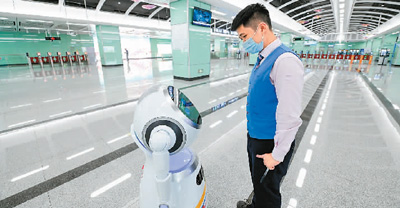Digital technologies provide subway passengers with better travel convenience
Thanks to the widespread use of digital technologies such as big data, cloud computing, artificial intelligence (AI), and 5G, smart subway systems across China have provided thoughtful services and a better travel experience for passengers.

Photo shows a robot in a metro station along Line 20 in Shenzhen, south China’s Guangdong Province. (Photo/Bao Gansheng)
At a Metro Line 6 station in Xi’an, capital of northwest China’s Shaanxi Province, an AI-based virtual “attendant” serving as an information assistant has a human voice and communication skills, enabling passengers to search for information. The “attendant” is able to answer passengers’ questions through the use of a touch screen. Meanwhile, a smart security check system empowered by technology such as intelligent identification has been put into use at all stations of the metro line, ensuring that both passengers and their personal belongings can go through security checks efficiently.
After registering an account on Guangzhou Metro’s official app with their authentic identity information, a passenger can make use of a facial recognition system to board and pay fares without having to swipe a transportation card at stations of Metro Line 18 in Guangzhou, capital city of south China’s Guangdong Province. During rush hour, the app, as well as the public address system, electronic screens, and escalators at stations will automatically inform passengers of the real-time crowd levels of carriages.
Some subway stations offer passengers exciting cultural experiences. A digital art museum was inaugurated at a metro station in Changsha, capital city of central China’s Hunan Province. The museum, the first of its kind in the country, includes six large-scale three-dimensional LED art installations, which transform part of the metro station into an art space, showcasing a blend of f of science, technology, and fashion. Built in an interchange metro station, the museum covers an area of 2,000 square meters.
“Thanks to the rapid development of smart metro systems, both the core function of the metro as a means of transportation and additional functions of the metro can be realized through the application of digital and intelligent technologies,” said Wang Peng, an associate professor at the Renmin University of China, adding that the intelligent development of metro systems brings more travel convenience to passengers.
Wang said that the integration of the metro and digital technologies creates more new application scenarios in aspects such as culture, tourism, advertising, and social contact, playing a big role in promoting culture and business development.
Amid the COVID-19 epidemic, intelligent equipment and systems in metro stations have also contributed to China’s epidemic prevention and control. For example, Fuzhou Metro in Fuzhou, southeast China’s Fujian Province has deployed intelligent thermal cameras that can automatically measure and record passengers’ body temperature, helping to avoid close contact while improving the efficiency of entering the subway stations.
Photos
Related Stories
- Air travel in China will get smarter as roadmap planned out
- China approves plan to digitalize government services
- Digital technologies fair featuring China opens in Istanbul
- More Chinese seniors becoming internet-savvy
- Digital technologies help with medical treatment in China
- Beijing to accelerate digital technology innovation
Copyright © 2022 People's Daily Online. All Rights Reserved.










